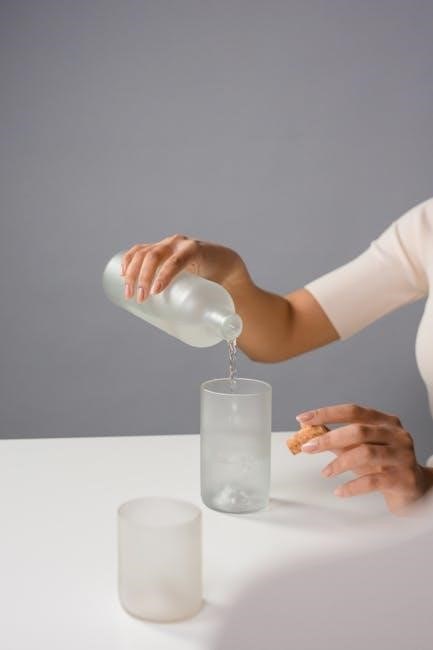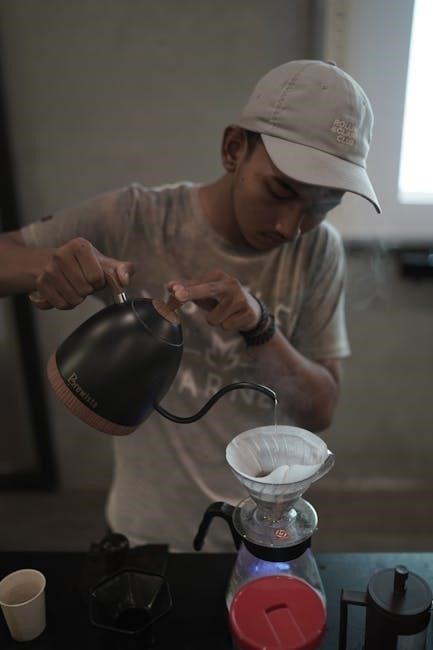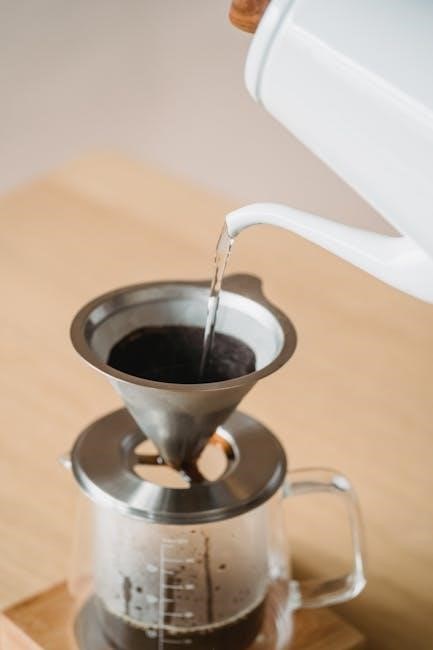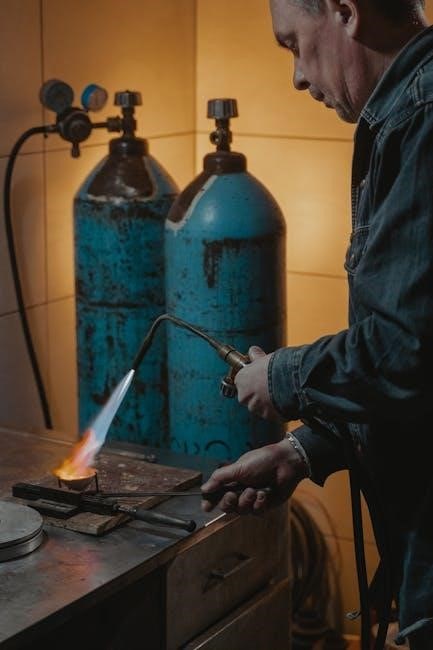The Truma Hot Water System is a reliable and efficient LPG and electric storage water heater designed for recreational vehicles and caravans‚ ensuring consistent hot water supply.
1.1 Overview of the Truma Hot Water System
The Truma Hot Water System‚ including models like UltraRapid and AquaGo‚ offers LPG and electric heating options‚ ensuring reliable hot water supply in caravans and RVs. Designed for efficiency‚ it combines storage water heater functionality with energy-saving features. The system is popular for its consistent performance‚ ease of use‚ and compatibility with various voltage systems. As highlighted in the 2024 Four Wheel Campers lineup‚ Truma systems are increasingly integrated into modern recreational vehicles‚ meeting the demand for convenient and high-performance hot water solutions. This system is a trusted choice for adventurers seeking comfort on the go.
1.2 Importance of the Truma Hot Water System Manual
The Truma Hot Water System manual is essential for understanding installation‚ operation‚ and maintenance procedures. It provides detailed instructions for LPG and electric modes‚ ensuring safe and efficient use. The manual includes troubleshooting guides‚ error code solutions‚ and safety precautions‚ helping users resolve issues quickly. Proper adherence to the manual prevents damage and ensures optimal performance. Available on platforms like ManualsLib‚ it serves as a critical resource for RV and caravan owners‚ offering clear guidance for maximizing the system’s benefits while minimizing risks. Keeping the manual handy is crucial for maintaining the system effectively.

Key Features of the Truma Hot Water System
The Truma Hot Water System offers LPG and electric heating options‚ storage water heater functionality‚ and high energy efficiency‚ ensuring reliable hot water supply in various conditions.
2.1 LPG and Electric Heating Options
The Truma Hot Water System offers dual heating options‚ allowing users to switch between LPG and electric modes. This flexibility ensures hot water availability even when one power source is unavailable. LPG mode is ideal for off-grid use‚ while electric mode is suitable for campsites with power hookups. The system automatically adjusts to the selected energy source‚ optimizing performance and efficiency. This feature is particularly beneficial for campers and caravan owners who need reliable hot water in diverse settings. The manual provides detailed instructions for safe and efficient operation of both heating options;
2.2 Storage Water Heater Functionality
The Truma Hot Water System features a storage water heater that provides a consistent and reliable supply of hot water. It operates by heating and storing water in an insulated tank‚ ensuring minimal energy consumption. The system is designed to maintain water temperature efficiently‚ even during periods of low usage. With a generous capacity and steady flow rate‚ it meets the needs of campers and caravan users. The storage functionality is compatible with both LPG and electric heating modes‚ offering flexibility and performance in various settings.
2.3 Energy Efficiency and Performance
The Truma Hot Water System is engineered for optimal energy efficiency and performance. Designed to minimize energy consumption‚ it ensures reliable hot water delivery while reducing waste. The system’s dual-power functionality allows seamless switching between LPG and electric modes‚ adapting to various energy sources. Its advanced insulation and heating elements maintain consistent water temperatures with minimal energy input. This makes it an eco-friendly choice for caravan and RV users‚ ensuring high performance without compromising on efficiency. The system is also compatible with newer models‚ enhancing its reliability and energy-saving capabilities for modern camping needs.

Installation Requirements
Proper installation of the Truma Hot Water System requires compliance with guidelines‚ ensuring safety and efficiency. Professional installation is recommended for optimal performance and system longevity.
3.1 Pre-Installation Checks
Before installing the Truma Hot Water System‚ ensure compatibility with your vehicle’s voltage and power capacity. Verify the system’s dimensions match the installation space and that ventilation requirements are met. Inspect all components for damage or defects. Ensure the area is clear of flammable materials and follows safety guidelines. Check local regulations for specific installation requirements. Properly plan the layout to avoid future maintenance issues. Consult the manual for detailed specifications and safety precautions to ensure a safe and efficient installation process.
3.2 Step-by-Step Installation Guide
Begin by preparing the installation site‚ ensuring it is level and meets ventilation requirements. Mount the Truma Hot Water System securely to the floor or wall using the provided brackets. Connect the water inlet and outlet hoses to the system‚ ensuring proper sealing to prevent leaks. Next‚ install the LPG and electric connections according to the manual’s specifications. Connect the electrical supply‚ ensuring it matches the system’s voltage requirements. Finally‚ test the system by running a full cycle to check for leaks and proper functionality. Refer to the manual for detailed diagrams and specific torque settings to ensure a safe and correct installation.
3.3 Safety Precautions During Installation
Always ensure the installation area is well-ventilated‚ especially when handling LPG components. Wear protective gloves and goggles to prevent injury. Follow the manual’s instructions precisely to avoid system damage or safety hazards. Before connecting gas lines‚ use a gas leak detector to ensure no leaks are present. Keep the system away from flammable materials and open flames during installation. Ensure all electrical connections are properly grounded to prevent shocks. Never attempt installation without proper training or authorization. After installation‚ conduct a thorough test to ensure safe and correct operation. Always refer to the manual for specific safety guidelines.

Operating the Truma Hot Water System
Operate the system by turning it on via the control panel. Monitor temperature and water flow. Ensure efficient operation by adjusting settings as needed for optimal performance.
4.1 Normal Operating Procedure
To operate the Truma Hot Water System normally‚ first ensure all connections are secure and the water tank is filled. Turn on the power supply and select the desired heating mode via the control panel. For LPG mode‚ ensure the gas bottle is opened and the ignition is successful. In electric mode‚ confirm the power is switched on; Once operational‚ set the temperature using the thermostat. Allow time for water to heat up before use. Monitor the system regularly to ensure proper function and follow all safety guidelines provided in the manual.
4.2 Switching Between LPG and Electric Modes
To switch between LPG and electric modes on the Truma Hot Water System‚ start by ensuring the system is turned off. For LPG to electric mode‚ close the gas bottle valve and select the electric option on the control panel. Confirm the switch by pressing the mode button until the display updates. For electric to LPG‚ ensure the gas bottle is open and select the LPG mode. The system will automatically ignite the burner. Always allow a few minutes for the system to adjust between modes. This ensures smooth transitions and prevents operational issues.

4.3 Adjusting Temperature Settings
To adjust the temperature on the Truma Hot Water System‚ use the control panel. Press the temperature adjustment buttons to increase or decrease the desired water temperature. The system allows settings between 40°C and 80°C. For energy efficiency‚ Truma recommends keeping the temperature around 60°C. After selecting the desired temperature‚ press “OK” to confirm. Always refer to the manual for model-specific instructions‚ as some systems may have additional features. Avoid exceeding the maximum temperature to prevent scalding or system damage. Regularly check the temperature to ensure it meets your needs and safety standards.

Maintenance and Servicing
Regular maintenance ensures optimal performance. Check for leaks‚ clean filters‚ and inspect heating elements. Ensure proper ventilation and annual servicing by a certified technician for longevity.
5.1 Routine Maintenance Checks
Regular maintenance is crucial for the Truma hot water system. Inspect the system for leaks‚ clean the filters‚ and check the anode rod for corrosion. Ensure proper ventilation to prevent gas buildup. Test the temperature-pressure relief valve annually. Check electrical connections for tightness and inspect the heating elements for scale buildup. Clean the exterior and ensure all components are secure. Regular checks help prevent malfunctions‚ improve efficiency‚ and extend the system’s lifespan. Always follow the manual’s guidelines for safe and effective maintenance procedures.
5.2 Replacing Parts and Filters
Replacing parts and filters in the Truma hot water system is essential for optimal performance. Regularly inspect and replace the anode rod to prevent corrosion. Check seals and gaskets for wear and tear‚ replacing them as needed. Change the water filters every 6-12 months to ensure clean water flow. Use genuine Truma replacement parts for compatibility and reliability. Always follow the manual’s instructions for disassembly and reassembly. Proper replacement ensures efficiency‚ prevents damage‚ and maintains water quality. Keep a stock of common spare parts to avoid unexpected downtime.
5.3 Winterizing the System
Winterizing the Truma hot water system is crucial to prevent damage from freezing temperatures. Start by draining the water heater and disconnecting the water supply. Use an RV-specific antifreeze to protect the system. Turn off the power and gas supply‚ then open all drain valves. Inspect the anode rod and replace it if necessary to prevent corrosion during storage. Check for any leaks and ensure all pipes are insulated. Store the system in a dry‚ protected area. Always refer to the manual for specific winterization steps or consult a professional if unsure. Proper winterization ensures the system remains functional and ready for future use.

Troubleshooting Common Issues
Troubleshooting common issues with the Truma hot water system involves identifying error codes‚ checking for leaks‚ and ensuring proper gas and electrical connections. Always refer to the manual for specific solutions or contact Truma support for professional assistance. Regular maintenance can help prevent many issues. If unsure‚ turn off the system and seek help to avoid further damage. Proper troubleshooting ensures reliable performance and extends the system’s lifespan. Always follow safety guidelines when addressing any issues.
6.1 No Hot Water Production
If the Truma hot water system fails to produce hot water‚ begin by checking the power supply and ensuring the system is properly switched on. Verify that the gas supply is adequate and the electrical connections are secure. If using LPG‚ ensure the gas bottle is not empty and the valve is fully open. Check the temperature settings and ensure the system is in operation mode. If issues persist‚ consult the manual for error codes or reset the system. Contact a professional if the problem remains unresolved to avoid further complications and ensure safety. Always follow the manual’s troubleshooting guide for accurate solutions.
6.2 Error Codes and Solutions
The Truma hot water system displays error codes to indicate specific issues. Common codes include E1 (temperature sensor fault)‚ E2 (overheating)‚ and E3 (low water flow). Refer to the manual for a full list of codes and their meanings. To resolve issues‚ restart the system‚ check sensors for blockages‚ and ensure proper water flow. For persistent errors‚ reset the system or replace faulty components. Always follow the manual’s guidance for troubleshooting and repairs. If unsure‚ contact a certified technician to avoid further damage. Regular maintenance can help prevent these errors and ensure optimal performance.
6.3 Leaks and Water Damage
Leaks and water damage can occur due to loose connections‚ worn seals‚ or corrosion. Inspect hoses‚ valves‚ and tank connections regularly. If a leak is detected‚ turn off the water and power supply immediately. Tighten any loose fittings and replace damaged seals or gaskets. Check the anode rod for corrosion and replace it if necessary. Addressing leaks promptly prevents water damage and extends the system’s lifespan. For severe issues‚ consult the manual or contact a professional. Regular maintenance can help identify potential leaks early‚ ensuring reliable operation and safety. Always follow the manufacturer’s guidelines for repairs.
Technical Specifications
The Truma system offers 14L water capacity‚ 1200W electric heating‚ and 12V compatibility‚ ensuring efficient performance for caravan and camping needs.
7.1 Power Consumption and Ratings
The Truma Hot Water System operates efficiently‚ with a power consumption of 1200W in electric mode and minimal LPG usage. It is designed for low energy draw‚ making it suitable for caravan and motorhome setups. The system is rated for 12V and 230V compatibility‚ ensuring flexibility across different power systems. Energy efficiency ratings highlight optimal performance‚ balancing power usage with consistent hot water delivery. These specifications make it ideal for off-grid and on-grid applications‚ providing reliable service while maintaining energy efficiency standards.
7.2 Water Capacity and Flow Rate
The Truma Hot Water System offers a water capacity of 10 or 14 liters‚ depending on the model‚ ensuring ample hot water supply for caravan and motorhome use. The flow rate is approximately 7-10 liters per minute‚ providing a steady supply for showers and sinks. Designed for efficiency‚ the system maintains consistent water temperature between 55°C and 65°C‚ catering to user preferences. This balance of capacity and flow rate ensures reliable performance while minimizing water and energy usage‚ making it ideal for both small and medium-sized applications on the go.
7.4 Compatibility with Different Voltage Systems
The Truma Hot Water System is compatible with both 12V and 230V electrical systems‚ ensuring versatility for various applications. This feature is particularly beneficial for travelers who encounter different voltage standards in different regions. The system’s universal compatibility simplifies usage across diverse settings. For proper function‚ users must configure the system according to the specific voltage supply. It is recommended to consult the manual or seek assistance from Truma customer support to ensure correct setup and avoid potential issues.

Safety Guidelines
Safety is a top priority when operating the Truma Hot Water System. Always comply with installation and usage standards to ensure safe and efficient operation. Adhere to manual guidelines and perform regular inspections to minimize risks and prevent potential hazards.
8.1 General Safety Precautions
Always wear protective gear‚ including gloves and safety glasses‚ when handling the Truma Hot Water System. Ensure the area is well-ventilated to prevent gas buildup. Never smoke or allow open flames near the system. Regularly inspect for leaks or damage and address issues promptly. Follow the manufacturer’s guidelines for installation‚ operation‚ and maintenance. Keep children and pets away from the system. Avoid touching hot surfaces and ensure proper installation of safety devices. Familiarize yourself with emergency shutdown procedures. Adhere to local safety regulations and standards for optimal safety and performance.
8.2 Ventilation Requirements
Proper ventilation is crucial for safe operation of the Truma Hot Water System. Ensure the system is installed in a well-ventilated area to prevent gas fumes accumulation. Use vents or fans to maintain airflow‚ especially in enclosed spaces. Keep vents clear of obstructions to ensure proper function. Regularly inspect ventilation systems for damage or blockages. Always follow local building codes and manufacturer guidelines for ventilation. Adequate airflow helps prevent carbon monoxide buildup and ensures efficient system performance. Maintain a clean and unobstructed ventilation path for optimal safety and functionality.
8.3 Emergency Shutdown Procedures
In case of an emergency‚ immediately switch off the power supply to the Truma Hot Water System at the circuit breaker. Turn off the gas supply valve if applicable. Close the isolation valves on the water inlet and outlet pipes to stop water flow. Allow the system to cool down before performing any maintenance or repairs. Always refer to the manual for specific shutdown procedures tailored to your model. Ensure all safety measures are followed to prevent accidents or further damage. Contact Truma customer support if unsure about any step. Regularly practice emergency procedures to ensure readiness.

Upgrading the Truma Hot Water System
Upgrading your Truma Hot Water System enhances performance and efficiency. Consider newer models or advanced features like digital controls or larger water heaters. Always consult the manual or contact Truma support for compatibility and installation guidance to ensure a smooth upgrade process. Regular updates help maintain optimal functionality and safety.
9.1 Compatibility with Newer Models
Upgrading to a newer Truma Hot Water System model often requires verifying compatibility with existing components. Ensure that the new model aligns with your current setup‚ such as plumbing‚ electrical connections‚ and LPG systems. Check the manual or manufacturer’s website for compatibility charts. Some newer models may offer backward compatibility‚ while others might need additional adapters or upgrades. Always consult Truma’s official resources or contact customer support to confirm compatibility before making any changes. This ensures a seamless transition and optimal performance of the upgraded system.
9.2 Upgrading from Basic to Advanced Models
Upgrading from a basic to an advanced Truma Hot Water System model enhances functionality and performance. Advanced models often feature improved energy efficiency‚ faster heating‚ and additional safety features. The upgrade process typically involves replacing the existing unit with the new model‚ ensuring compatibility with your current setup. Always refer to the manual for specific instructions‚ as some models may require software updates or hardware modifications. Truma’s customer support can assist with compatibility checks and installation guidance‚ ensuring a smooth transition to the advanced model.
9.3 Integrating with Other Truma Systems
Integrating the Truma Hot Water System with other Truma systems‚ such as heating or HVAC units‚ enhances overall performance and efficiency. This seamless integration allows for synchronized operation‚ reducing energy consumption and improving comfort. The system is designed to work harmoniously with other Truma components‚ ensuring compatibility and optimal functionality. Always consult the manual for specific integration guidelines and compatibility checks. Proper integration requires following the manufacturer’s instructions and may involve software updates or adjustments to ensure all systems work together effectively. This feature is a key advantage of Truma’s comprehensive system design.
The Truma Hot Water System offers efficient‚ reliable performance‚ combining innovative technology with user-friendly design. This manual provides comprehensive guidance for optimal use‚ maintenance‚ and ensuring safety.
10.1 Summary of Key Points
The Truma Hot Water System is a versatile and efficient solution for providing hot water in caravans and motorhomes. It offers both LPG and electric heating options‚ ensuring flexibility in different situations. Proper installation and regular maintenance are crucial for optimal performance and safety. The system’s energy-efficient design helps reduce power consumption while delivering consistent hot water supply. Troubleshooting common issues and understanding error codes can prevent major problems. Always follow safety guidelines and ventilation requirements to ensure safe operation. Regular servicing and winterizing the system will extend its lifespan and maintain reliability. This manual serves as a comprehensive guide to maximize the system’s potential and ensure user satisfaction.
10.2 Final Tips for Optimal Performance
To ensure your Truma Hot Water System performs at its best‚ always conduct routine checks on the anode rod and seals to prevent corrosion. Regularly clean the water heater and its surroundings to maintain efficiency. Adjust temperature settings according to your needs to conserve energy. Monitor your water usage patterns to optimize heating times. Run a cleaning cycle annually to remove mineral buildup; Use the correct LPG pressure and ensure proper ventilation for safe operation. Store the system correctly during off-seasons to prevent damage. By following these tips‚ you can enjoy reliable hot water and extend the system’s lifespan.
10.3 Importance of Regular Maintenance
Regular maintenance is crucial for ensuring the longevity and efficiency of your Truma Hot Water System. It helps prevent scaling and corrosion‚ which can reduce performance and lead to premature wear. By inspecting and replacing worn-out parts‚ you can avoid unexpected breakdowns and costly repairs. Maintenance also ensures safe operation by preventing gas or water leaks. Over time‚ regular upkeep enhances energy efficiency and maintains consistent hot water supply. A well-maintained system not only lasts longer but also performs better‚ providing reliable service for years to come. Consistency in maintenance is key to optimal functionality and safety.

Additional Resources
For further assistance‚ refer to the Official Truma Hot Water System Manual‚ contact Truma Customer Support‚ or explore online forums and communities for user insights and solutions.
11.1 Official Truma Hot Water System Manual
The Official Truma Hot Water System Manual is an essential resource for understanding and maintaining your system. It provides detailed installation‚ operation‚ and maintenance instructions. The manual includes troubleshooting guides‚ technical specifications‚ and safety precautions. Available on Truma’s official website or through authorized dealers‚ it ensures users can optimize performance and address issues effectively. Regularly updated‚ the manual reflects the latest system improvements and safety standards‚ making it a critical reference for both new and experienced users. Always consult the manual before performing any maintenance or repairs.
11.2 Truma Customer Support and Service Centers
The Truma Customer Support and Service Centers provide comprehensive assistance for hot water system users. With a dedicated team available via phone‚ email‚ or online portals‚ Truma ensures quick resolution of queries and issues. Service centers are strategically located worldwide‚ offering professional repairs‚ maintenance‚ and genuine replacement parts. Truma’s support network is designed to maximize system performance and longevity. Customers can rely on expert advice and timely service‚ ensuring uninterrupted access to hot water. Regularly updated training programs for service technicians guarantee high-quality support tailored to user needs.
11.3 Online Forums and Communities
Online forums and communities dedicated to the Truma Hot Water System offer valuable resources for users. These platforms provide a space for sharing experiences‚ troubleshooting tips‚ and advice from experienced users. Members can access detailed guides‚ tutorials‚ and real-time support from enthusiasts and professionals. Additionally‚ these communities often feature discussions on the latest updates‚ mods‚ and maintenance practices. Engaging with these forums can enhance user knowledge and help resolve issues quickly. Active participation fosters a supportive environment‚ ensuring users get the most out of their Truma system.
